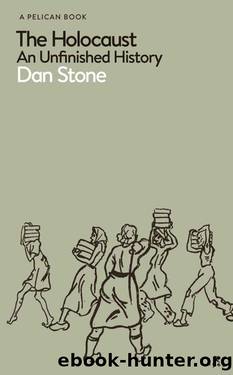The Holocaust (Pelican Books) by Dan Stone

Author:Dan Stone [Stone, Dan]
Language: eng
Format: epub
ISBN: 9780241388716
Publisher: Penguin Books Ltd
Published: 2023-01-25T16:00:00+00:00
Auschwitz, the domain of the âcultured demonsâ, may not have been the site where most of the Jews killed in the Holocaust died but it marked the apogee of the murder process and is rightly remembered as such.
In late 1943 and early 1944 the killing rate slowed at Birkenau, as the Nazis realized that placing ideology above labour made little sense now, given the parlous state of the war economy and the military situation after Stalingrad. The increasingly desperate needs of the war economy drove the Nazi leadership to reconsider its killing programme â a remarkable fact given the drive to murder Jews that was central to Nazism. From 1943 onwards Jews and others were as likely to end up in slave-labour sub-camps attached to the SSâs main camps as they were to be murdered outright. In fact, between 210,000 and 220,000 inmates, the majority of them Jews, were transferred from Auschwitz to other camps, including Auschwitzâs sub-camps.43 The rapid growth in the sub-camp system is something that histories of the Holocaust often fail to explain, but it does not downplay Nazi genocidal plans to show that they were attenuated to a small extent in the final year and a half of the war. Rather, when one considers the ways in which slave labourers were treated, the exact opposite is the case. If one cannot always talk of âannihilation through labourâ (this is a term which does not occur very often in the sources), nevertheless the Nazisâ attitude, even when labour needs were acute, was that Jews were expendable and that no effort should be made to ensure that productivity levels could become anything like those for normal labourers.
Even within sites which today appear silent and still, the hubbub of movement on the part of guards, SS, civilians and inmates meant that the camp was âalways in motionâ.44 For the victims, this movement was overwhelmingly bewildering, and sub-camp inmates often did not even know where they were. The fact is, however, that the use of Jews as slave labourers saved the lives of several hundred thousands who would otherwise have simply been killed. Even if their deaths were being deferred, their lives were prolonged as a result of the unexpected flexibility of the Nazisâ racial laws from late 1943 onwards in reaction to the desperate needs of the war economy. âThese campsâ, one historian notes, âwere among the best options available for Jews; for other inmates they were usually the worst. Jews were worst affected, but it would be incorrect to say that their labour ability played no role in their fate under the Germans.â45
This flexibility should not be overstated; it was a last-ditch measure, and the survivors were simply fortunate that the war did not last even a few days longer, for otherwise their number would have been even smaller. But the use of Jews as slave labourers was, from the Nazisâ ideological point of view, ironic. The vast expansion of the sub-camp system and, especially, the death marches
Download
This site does not store any files on its server. We only index and link to content provided by other sites. Please contact the content providers to delete copyright contents if any and email us, we'll remove relevant links or contents immediately.
| Holocaust |
Cecilia; Or, Memoirs of an Heiress — Volume 1 by Fanny Burney(31341)
Cecilia; Or, Memoirs of an Heiress — Volume 3 by Fanny Burney(30938)
Cecilia; Or, Memoirs of an Heiress — Volume 2 by Fanny Burney(30896)
The Secret History by Donna Tartt(16644)
Sapiens: A Brief History of Humankind by Yuval Noah Harari(13067)
Leonardo da Vinci by Walter Isaacson(11912)
The Radium Girls by Kate Moore(10914)
Sapiens by Yuval Noah Harari(4546)
The Wind in My Hair by Masih Alinejad(4427)
How Democracies Die by Steven Levitsky & Daniel Ziblatt(4407)
Homo Deus: A Brief History of Tomorrow by Yuval Noah Harari(4287)
Endurance: Shackleton's Incredible Voyage by Alfred Lansing(3852)
The Silk Roads by Peter Frankopan(3771)
Man's Search for Meaning by Viktor Frankl(3644)
Millionaire: The Philanderer, Gambler, and Duelist Who Invented Modern Finance by Janet Gleeson(3574)
The Rape of Nanking by Iris Chang(3522)
Hitler in Los Angeles by Steven J. Ross(3443)
The Motorcycle Diaries by Ernesto Che Guevara(3340)
Joan of Arc by Mary Gordon(3262)
